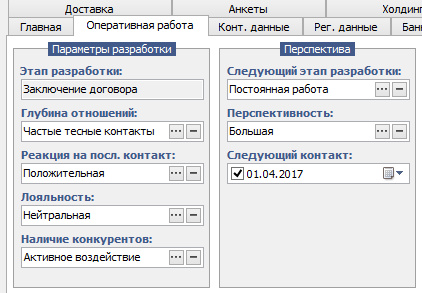The way to deal in CRM: automate it
What about what, and we are about commerce. Do you know why all of us are so annoyed by sales? They most often look like a stream of talking, talking and imposing. And so sell everything: from software to cars. Salespeople have their own logic, but often they play against them: the deals are frustrated precisely because of the very irritation of the client.
Meanwhile, the software has long been in the service of sales departments, is able to accompany transactions and make them almost perfect - pure engineering for the benefit of commerce. Today we will talk about transactions, their stages and automation of the whole story. We will try to sort through.
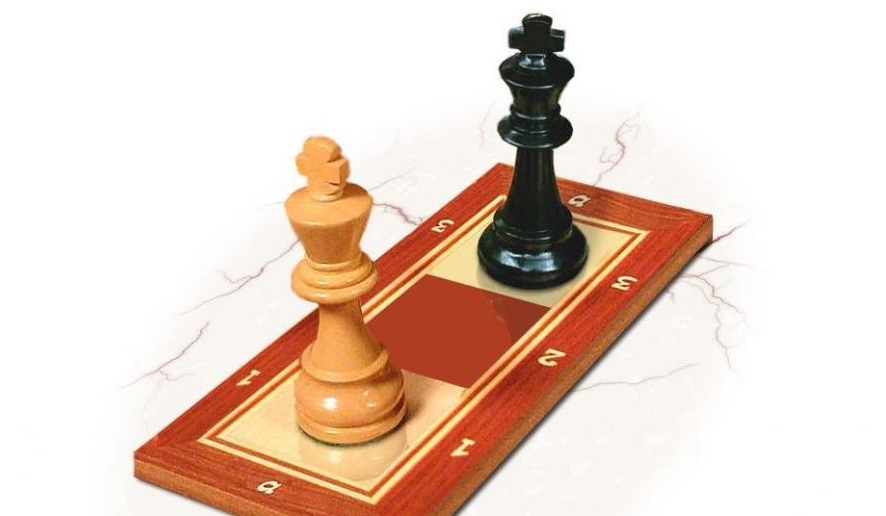
Let's define what a transaction is and what we will mean by it for the purposes of the article.
Everyone looks at deals differently. From the point of view of a lawyer, this is an action of a natural or legal person aimed at establishing, changing or terminating civil rights and obligations. From the seller’s point of view, a transaction is an act of selling, exchanging goods and services for money or other benefits. From the point of view of a CRM box, a transaction is the result of a multi-step process. So, it's time to highlight the stages of the sale process and the proportion of time they take.
')

So, the transaction is the central element of the sales system and the main part of the sales cycle. It is also the goal of the business process, it is also a source of revenue, it is also a component of the KPI of employees. Not every customer comes to a transaction, it is important to be able to correctly conduct it from the lead to the payment of an invoice or even to the pre-sale. As a rule, the qualification of a sales manager is not enough for this - automation is needed. And taking into account the fact that each of your clients is also processed by competitors, this should be smart automation, which will harmoniously and logically help guide a potential buyer on the way from lead to counting. This, in fact, is the most important purpose of the CRM-system.
The two most popular judgments related to the automation of the sales process and transactions. Both are untenable.
In the end, we will talk about interesting figures, which show how much CRM is needed for operational work and intensive development of the company. In short, without a CRM, a business is either marking time or rolling back. The prospects are so-so.
To demonstrate automation, as usual, we use our CRM-system RegionSoft CRM , the benefit is that over the 10 years of its existence, we have developed several interesting mechanisms that traditionally cause a wow effect on presentations. And in the process of use, they cause the effects of “clients ++” and “revenue ++”. In the course of the post with us - checklists for transactions and short tips on how to behave at each stage, so that it does not become the last.
If you sell your software / server / SaaS, another product / service is not the first day, then you already have an idea of what stages the client goes through. That is, you have a vision funnel. Configure its profile in CRM: write down the stages of client development and name them as clearly as possible. Later you can browse the funnel profiles by company, by industry, by managers and other necessary parameters to find out where those bottlenecks are where customers are lost.


How to determine the bottleneck? Look at the funnel. Where there is an extreme narrowing, there is a bottleneck. After all, if you manage to reduce the coefficient of blade customers during the passage of this place, the total exhaust in the transaction will increase in direct proportion. To reduce the blade ratio, it is necessary to analyze its causes and make adjustments, for example, in the work of sellers who are responsible for working with customers at this stage.
It should also be borne in mind that each manager may have his own bottleneck. Therefore, if you stupidly break the transaction process into several managers, putting at each stage of the one at which the efficiency factor is higher at this stage of the transaction, you will reduce the effect of the blade and increase the number of customers reaching the final stages of the transaction.
The important point is to create the client development stages correctly, this is where the automation will begin. Here's how it happens: you create client development steps in the CRM directory (they are partially registered by us, and each user is partially prescribed based on business objectives). Creating stages, you set goals that can be achieved within this stage, create an automatic response of the system to the achievement of goals:
Goals can be any number. For example, the negotiation phase leads either to the receipt of requirements, or to readiness for the purchase, or to refusal, or to delay the decision, etc.
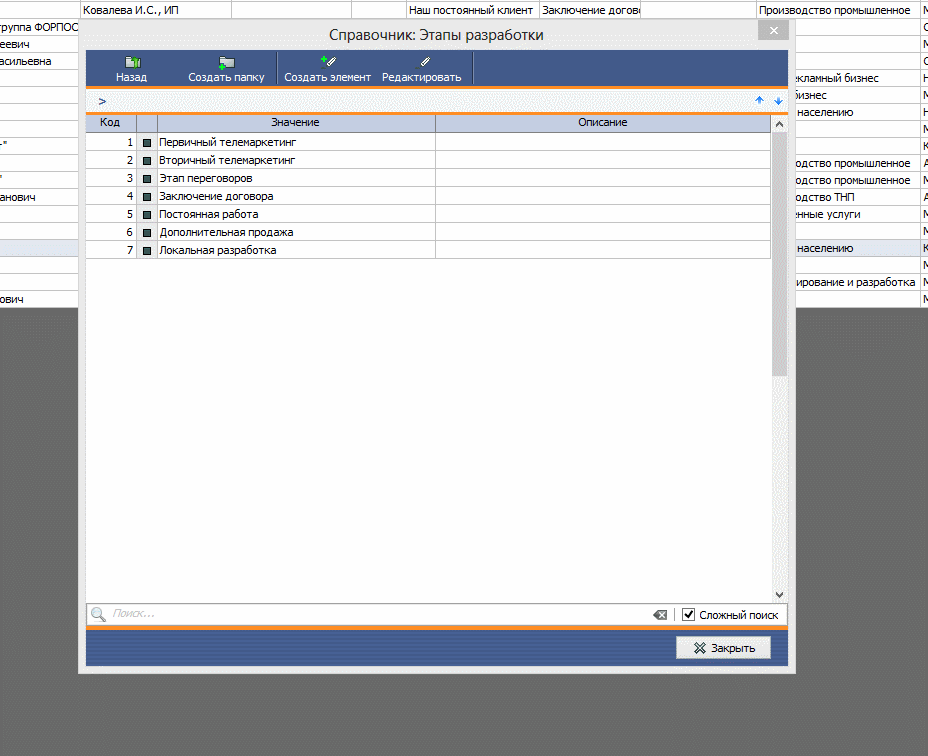
GIF on how target targeting works in RegionSoft CRM
Thus, the automatic targeting mechanism works in RegionSoft CRM : the client automatically moves to a new development stage when the target is reached. In this case, even an inexperienced manager copes with the sale - he does not need to analyze the course of the transaction, it is enough to indicate the achieved goals. Work efficiency is greatly enhanced by eliminating the human factor. In fact, the computer knows in advance what stage the sales cycle is at and translates actions to the right managers.
What is important at this stage:
The main thing that is important to remember at this stage is that automation should not be patchwork. That is, if after the initial call the stage has changed automatically, and then everything went at the discretion of the managers, you can get a negative effect due to the non-binding and forgetfulness of the employees. It happens to everyone, but it's better not to risk it.
If there are business processes in the CRM system, that's great. If you set them up - well. If you have set them up and included them in the process of moving a client to a transaction - excellent. Business processes automate repetitive routine activities: delivery, signing of documents, coordination, shipment, and so on. Thus, when working with the next client, you can simply launch an instance of the business process, which, like target targeting, will work out the actions in a strict sequence and send out reminders about the actions to all those responsible.
For example, contact with the customer involves delivery. Delivery within the company takes place in all cases about the same - this is a routine process that must be prescribed as an algorithm. Someone does this using BPMN notation, we decided to do CRM for everyone, not for programmers, so we created our own user-friendly editor and visual graphical representation in it. Here's how the delivery process in RegionSoft CRM looks like a typical human-readable chain of actions:

What is important at this stage:
So, all the preparatory work has been done: the development stages have been registered, typical processes have been created, responsible and deadlines have been determined. CRM-system is ready to accept the first client (only with the manager!). In fact, not always with the manager - but more on that below.
Passing the sales ladder is the stage of tight interaction with the client, when your task is to satisfy his needs and thereby receive revenue for the company. Ideally, the more you communicate with a client, the more loyal it becomes to you. This is how it can be represented graphically.

Ladder of sales. Although, probably, it is rather an escalator, since even a regular customer can go all the way again or turn to a competitor when re-selling.
However, this way the staircase looks only on the diagram in our blog. Usually there are dips under the abscissa, and at any time. Not to say that using a CRM system is a panacea for failures and the picture is guaranteed, but automation solves some of the typical problems within customer relations.
Solving these three problems is enough for the client to be rid of most of the irritants from your company. The ladder becomes like a ladder, not a roller coaster.
When a client enters your development and you enter it into a CRM system, it is important that operational classifiers are registered in the client’s card (which will change in the future according to the targeting settings). These include:
By clicking you can see the entire client card
This set of classifiers not only makes the customer base more qualitative, and the operational work convenient, but also allows you to use filters in the main table. You can easily select a group of clients with preset operational development parameters. And when you have such a group in your hands, you can make point effects - for example, make stimulating mailings. Somehow: choose all loyal customers for whom there are a lot of competitive offers, and the last communication for some reason did not ask (prices for their goods increased) and influence them by offering a discount, free shipping, a bonus or just apologizing.
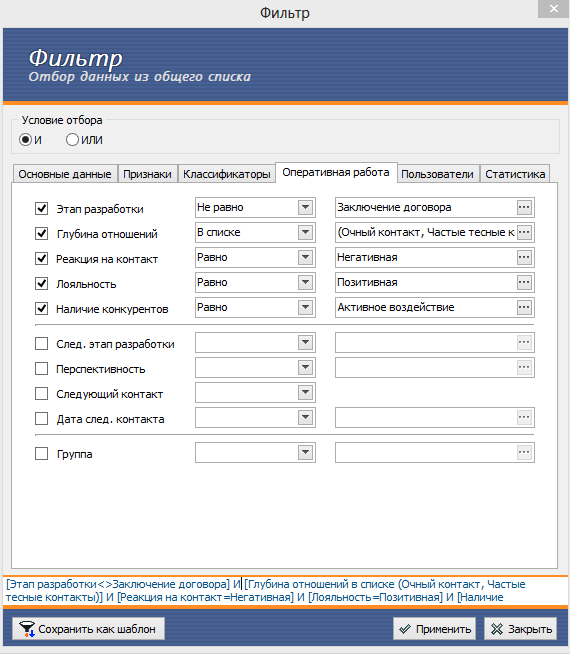
As a result, CRM and managers did a good job - the client asks for an account. There is a golden rule here: if a customer has asked for an invoice, drop everything, immediately make an invoice and transfer it to the customer for payment. And again, CRM helps out - just select the names of the goods and generate an invoice with one click. At the same time, the sale in the client's card may not be created - you will form it later based on the invoice.
Is able to - in the event that it interacts with the company's website and personal account of users (for example, when you create purchase requests on your site through a personal account or without it). The client places an order on your site, and with the help of the RegionSoft Application Server, the order gets into the CRM system, where the client card is created, tasks are automatically set and business processes are started, if necessary. And when CRM starts working with the client and the stages of its development change, the data is exchanged again and the change of these stages is displayed in the personal account or order profile on the site.
This solution to the problem is implemented so that online stores and websites with the option of order collect requests in CRM automatically. No inconspicuous CRM and other magic - the usual and very reliable software solution.
Without problems, mistakes and blunders, there is no work, let alone sales. But a wise leader differs from the usual in that he does not punish for non-systematic blunders, but regards them as opportunities for analysis and development. In RegionSoft CRM thirty-two reports related to sales: from the funnel to the dynamics of development and promotion of the sales ladder. All this information should be analyzed and corrected in the tactics of the work of managers.
What is important at this stage:
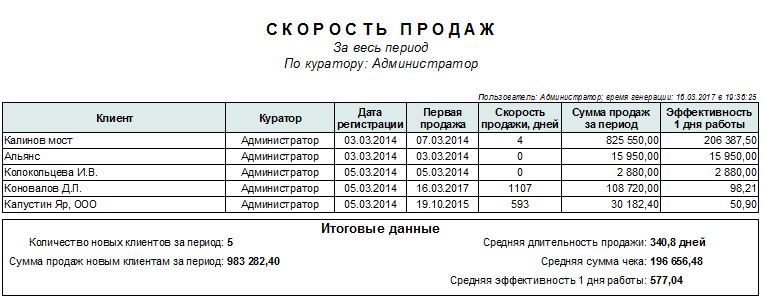
We have already written about the cycles and speed of sales - this is one of the most important reports, which should be in any CRM-ke, because it displays the "health" of processes, allows you to identify complex customers and lazy managers.
In order for the transaction to take place, it is not enough to have a staff of managers, a product and a CRM system. It is important that there is a clear plan of action and not a single trifle falls out of the chain of relations with the client. What you need to remember?
Let's judge not as merchants, but as engineers. The sales process is a defined and repetitive set of meaningful customer interactions. During the process, the team uses its experience and performs actions to make a deal. Important: to collect requirements, to provide the buyer with information about the decision.
The chain of significant events: the creation of development stages, setting up business processes → launching automatic processes → displaying the status of transactions → recording sales progress → forecasting incomes and expenses → closing a transaction → evaluating indicators, the level of implementation of the plan.
Such a process directly requires automation: recording and processing interactions, increasing the speed of the sales cycle, storing data about all relationships. Here, just the CRM-system manifests itself in the original sense of SFA - automating the process of increasing sales.
Just at the end of last year, Forbes Insights released the report “THE POWER OF ENABLEMENT”, in which it looked at how market leaders and ordinary companies interact with software. So, 53% of them invest in CRM-systems to increase sales productivity. But much more telling is what companies are trying to achieve with the help of automation (in the Best survey, these are companies that are much higher than the market, proactive leaders, and Rest are the rest of the firms in the sample).
48% of the best and 28% of the rest seek to shorten the sales cycle - that is, to actually solve the main business problem. It is very significant that this task is given priority to those who are used to leading, while the rest pay greater attention to the detuning from competitors and conversion. Again, a vivid example of the difference between the intensive development path and the extensive one.
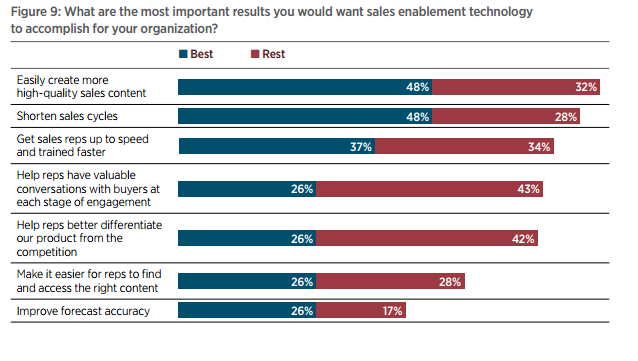
Transactions do everything: vendors CRM, software developers, hosting, manufacturers of goods, retail, etc. And it is important that the path to them be as short and cheap as possible in the overhead plans. Today only automation and competent analysis from the management helps in this. If to speak more simply, to conduct transactions without CRM-systems - just nothing. Even easier - without automation, you are trying to drive while holding the business on the handbrake. Go to nitrous oxide. As one very successful head of a very well-known IT-company said, a business should work at the speed of thought!
Meanwhile, the software has long been in the service of sales departments, is able to accompany transactions and make them almost perfect - pure engineering for the benefit of commerce. Today we will talk about transactions, their stages and automation of the whole story. We will try to sort through.

It is done
Let's define what a transaction is and what we will mean by it for the purposes of the article.
Everyone looks at deals differently. From the point of view of a lawyer, this is an action of a natural or legal person aimed at establishing, changing or terminating civil rights and obligations. From the seller’s point of view, a transaction is an act of selling, exchanging goods and services for money or other benefits. From the point of view of a CRM box, a transaction is the result of a multi-step process. So, it's time to highlight the stages of the sale process and the proportion of time they take.
')

So, the transaction is the central element of the sales system and the main part of the sales cycle. It is also the goal of the business process, it is also a source of revenue, it is also a component of the KPI of employees. Not every customer comes to a transaction, it is important to be able to correctly conduct it from the lead to the payment of an invoice or even to the pre-sale. As a rule, the qualification of a sales manager is not enough for this - automation is needed. And taking into account the fact that each of your clients is also processed by competitors, this should be smart automation, which will harmoniously and logically help guide a potential buyer on the way from lead to counting. This, in fact, is the most important purpose of the CRM-system.
It cannot be automated! vs Dismiss all, CRM itself will sell!
The two most popular judgments related to the automation of the sales process and transactions. Both are untenable.
- It cannot be automated! It is possible, and in different CRM-systems there are different views and ways of automation: from primitive to customizable funnels and included business processes.
- Dismiss all, CRM itself will sell! This is a story generated by vendors, who say that the CRM-system itself leads the lead before the transaction, without the participation of the employee. Such functionality has not yet been invented, and it is impossible to invent it in principle: almost every business process requires human participation, especially when it comes to interaction with another person. Software does not know how to sell - only a living person works intuitively. Software is designed to save time, help, orient and direct, in general, serve as a tool.
In the end, we will talk about interesting figures, which show how much CRM is needed for operational work and intensive development of the company. In short, without a CRM, a business is either marking time or rolling back. The prospects are so-so.
So, automate the path to the transaction - we work in CRM
To demonstrate automation, as usual, we use our CRM-system RegionSoft CRM , the benefit is that over the 10 years of its existence, we have developed several interesting mechanisms that traditionally cause a wow effect on presentations. And in the process of use, they cause the effects of “clients ++” and “revenue ++”. In the course of the post with us - checklists for transactions and short tips on how to behave at each stage, so that it does not become the last.
Part 1. Comprehension
If you sell your software / server / SaaS, another product / service is not the first day, then you already have an idea of what stages the client goes through. That is, you have a vision funnel. Configure its profile in CRM: write down the stages of client development and name them as clearly as possible. Later you can browse the funnel profiles by company, by industry, by managers and other necessary parameters to find out where those bottlenecks are where customers are lost.


How to determine the bottleneck? Look at the funnel. Where there is an extreme narrowing, there is a bottleneck. After all, if you manage to reduce the coefficient of blade customers during the passage of this place, the total exhaust in the transaction will increase in direct proportion. To reduce the blade ratio, it is necessary to analyze its causes and make adjustments, for example, in the work of sellers who are responsible for working with customers at this stage.
It should also be borne in mind that each manager may have his own bottleneck. Therefore, if you stupidly break the transaction process into several managers, putting at each stage of the one at which the efficiency factor is higher at this stage of the transaction, you will reduce the effect of the blade and increase the number of customers reaching the final stages of the transaction.
The important point is to create the client development stages correctly, this is where the automation will begin. Here's how it happens: you create client development steps in the CRM directory (they are partially registered by us, and each user is partially prescribed based on business objectives). Creating stages, you set goals that can be achieved within this stage, create an automatic response of the system to the achievement of goals:
- Transfer of the client to the next stage of the transaction - CRM will transfer the client to a new stage and to a new responsible one. In this case, the automation allows not to lose contact, but to transfer the client from level to level, taking into account the qualifications of managers, response times, the importance of the next contact, etc.
- Changing customer status. When creating a goal, you specify the level of importance of the client. For example, it can be established that customers who have entered the stage of concluding a contract are marked as important - managers will give this group additional attention.
- The task assigned to the employee at the end of the stage. Upon reaching the goal, the system will create a task or notification that will come to the responsible specialist. For example, at the negotiation stage, this may be a reminder task of sending a quotation or a request for a TK, and at the stage of signing documents the task may be sent to the legal department for agreement negotiation.
Goals can be any number. For example, the negotiation phase leads either to the receipt of requirements, or to readiness for the purchase, or to refusal, or to delay the decision, etc.

GIF on how target targeting works in RegionSoft CRM
Thus, the automatic targeting mechanism works in RegionSoft CRM : the client automatically moves to a new development stage when the target is reached. In this case, even an inexperienced manager copes with the sale - he does not need to analyze the course of the transaction, it is enough to indicate the achieved goals. Work efficiency is greatly enhanced by eliminating the human factor. In fact, the computer knows in advance what stage the sales cycle is at and translates actions to the right managers.
What is important at this stage:
- think carefully and prescribe all stages in advance - so all sales in CRM, starting with the first, will be a full-fledged customer base
- establish the smallest possible transition from stage to stage
- include the goals and objectives of staff of all departments involved.
The main thing that is important to remember at this stage is that automation should not be patchwork. That is, if after the initial call the stage has changed automatically, and then everything went at the discretion of the managers, you can get a negative effect due to the non-binding and forgetfulness of the employees. It happens to everyone, but it's better not to risk it.
Part 2. Business Processes
If there are business processes in the CRM system, that's great. If you set them up - well. If you have set them up and included them in the process of moving a client to a transaction - excellent. Business processes automate repetitive routine activities: delivery, signing of documents, coordination, shipment, and so on. Thus, when working with the next client, you can simply launch an instance of the business process, which, like target targeting, will work out the actions in a strict sequence and send out reminders about the actions to all those responsible.
For example, contact with the customer involves delivery. Delivery within the company takes place in all cases about the same - this is a routine process that must be prescribed as an algorithm. Someone does this using BPMN notation, we decided to do CRM for everyone, not for programmers, so we created our own user-friendly editor and visual graphical representation in it. Here's how the delivery process in RegionSoft CRM looks like a typical human-readable chain of actions:

What is important at this stage:
- pinpoint process milestones, deadlines and responsibilities
- register links in the process card so that it works within the sales cycle
- start the process at the right time so that all tasks are completed on time.
So, all the preparatory work has been done: the development stages have been registered, typical processes have been created, responsible and deadlines have been determined. CRM-system is ready to accept the first client (only with the manager!). In fact, not always with the manager - but more on that below.
Part 3. Passing the sales ladder
Passing the sales ladder is the stage of tight interaction with the client, when your task is to satisfy his needs and thereby receive revenue for the company. Ideally, the more you communicate with a client, the more loyal it becomes to you. This is how it can be represented graphically.

Ladder of sales. Although, probably, it is rather an escalator, since even a regular customer can go all the way again or turn to a competitor when re-selling.
However, this way the staircase looks only on the diagram in our blog. Usually there are dips under the abscissa, and at any time. Not to say that using a CRM system is a panacea for failures and the picture is guaranteed, but automation solves some of the typical problems within customer relations.
- Forgotten deadlines, calls, meetings, clients' names, not sent out to KP - the first thing the CRM system struggles with, which allows you to set tasks, plan time and reminds the user about events and necessary actions. Business processes in it do the same thing: they send responsible notices that it is their turn to take part in solving the problem.
- Procrastination is the trouble of modern offices with unlimited access to the Internet and a coffee machine. CRM and the young man here: each manager in the main window of the system on the right sees his KPI panel for a day, a week and a month and knows for sure that a couple of extra smoke breaks and Adme site views are not advanced KPI progress bar; KPIs are not fulfilled - less money - worse mood - more boring work. Do not do it this way.
- Incorrectly compiled documentation, three hundred times reworked contracts, inadequate commercial proposals without calculations - we all faced this, from the secretary to the general director. This approach is annoying to customers, as it takes their time for their own money. We have exterminated this issue in the bud: RegionSoft CRM loads sample document forms, current versions of primary forms, internal document templates, and the manager can upload documentation to beautiful print forms in one click.
Solving these three problems is enough for the client to be rid of most of the irritants from your company. The ladder becomes like a ladder, not a roller coaster.
When a client enters your development and you enter it into a CRM system, it is important that operational classifiers are registered in the client’s card (which will change in the future according to the targeting settings). These include:
- the current stage of development;
- depth of relationship;
- reaction to the last contact;
- loyalty;
- presence of competitors with listing of competitors and their offers;
- the next stage of development;
- assessment of prospects;
- date of the next contact.
By clicking you can see the entire client card
This set of classifiers not only makes the customer base more qualitative, and the operational work convenient, but also allows you to use filters in the main table. You can easily select a group of clients with preset operational development parameters. And when you have such a group in your hands, you can make point effects - for example, make stimulating mailings. Somehow: choose all loyal customers for whom there are a lot of competitive offers, and the last communication for some reason did not ask (prices for their goods increased) and influence them by offering a discount, free shipping, a bonus or just apologizing.

As a result, CRM and managers did a good job - the client asks for an account. There is a golden rule here: if a customer has asked for an invoice, drop everything, immediately make an invoice and transfer it to the customer for payment. And again, CRM helps out - just select the names of the goods and generate an invoice with one click. At the same time, the sale in the client's card may not be created - you will form it later based on the invoice.
Screenshots of invoicing and billing in CRM
Account creation form in RegionSoft CRM
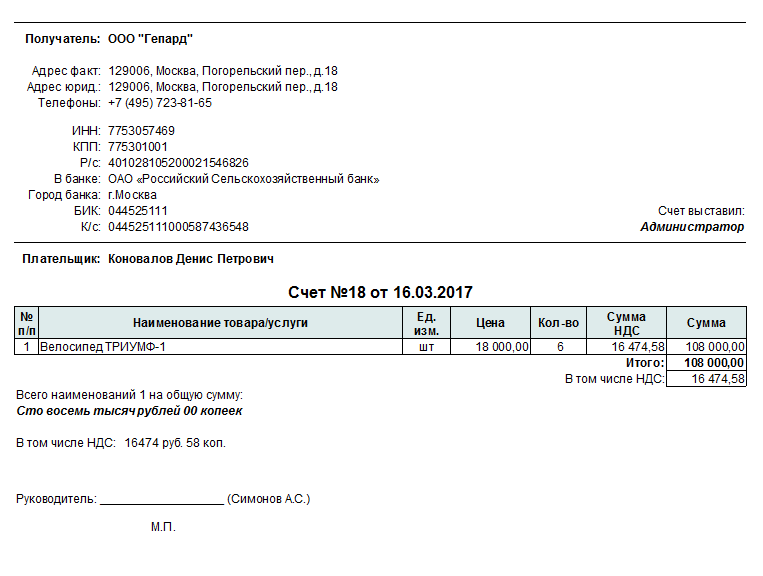
Beautiful and neat printed account form in RegionSoft CRM
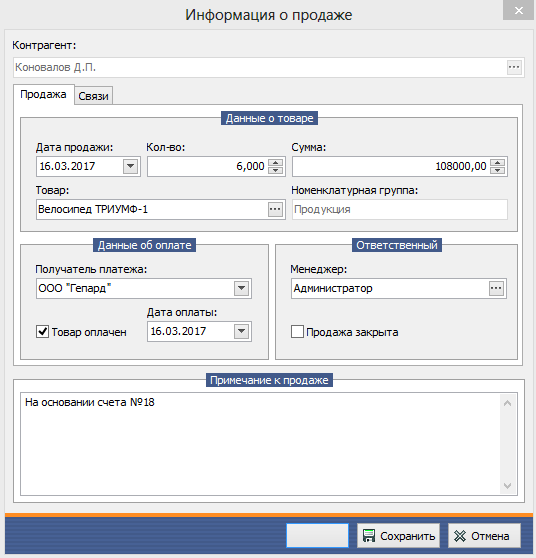 Desired moment: the product is paid, the sale is made
Desired moment: the product is paid, the sale is made

Account creation form in RegionSoft CRM

Beautiful and neat printed account form in RegionSoft CRM

CRM can work on its own
Is able to - in the event that it interacts with the company's website and personal account of users (for example, when you create purchase requests on your site through a personal account or without it). The client places an order on your site, and with the help of the RegionSoft Application Server, the order gets into the CRM system, where the client card is created, tasks are automatically set and business processes are started, if necessary. And when CRM starts working with the client and the stages of its development change, the data is exchanged again and the change of these stages is displayed in the personal account or order profile on the site.
This solution to the problem is implemented so that online stores and websites with the option of order collect requests in CRM automatically. No inconspicuous CRM and other magic - the usual and very reliable software solution.
Part 4. Reporting
Without problems, mistakes and blunders, there is no work, let alone sales. But a wise leader differs from the usual in that he does not punish for non-systematic blunders, but regards them as opportunities for analysis and development. In RegionSoft CRM thirty-two reports related to sales: from the funnel to the dynamics of development and promotion of the sales ladder. All this information should be analyzed and corrected in the tactics of the work of managers.
What is important at this stage:
- not limited to 1-2 reports, consider the indicators in the complex
- take different data cuts, compare indicators by groups of clients, managers, industries, etc.
- Do not leave suspicious numbers without attention, go into solving problems.

We have already written about the cycles and speed of sales - this is one of the most important reports, which should be in any CRM-ke, because it displays the "health" of processes, allows you to identify complex customers and lazy managers.
Business Checklist
In order for the transaction to take place, it is not enough to have a staff of managers, a product and a CRM system. It is important that there is a clear plan of action and not a single trifle falls out of the chain of relations with the client. What you need to remember?
The transaction should have several signs:
- transaction value - the amount that the company will save after closing the sale
- the cost of the transaction - the cost of the resources needed to make the transaction (agree that it is unprofitable to fly from Moscow to Langepas to sell the network monitoring program for 2 places for a total of 32,000 rubles - you need to consider the options for online presentation, delivery and training)
- the transaction holder is the manager who controls the transaction and completes it (for example, sales call was received by the call-center employee Ira, and salesman Misha took the presentation, training and sale. Michael was the holder)
- date - approximate date of completion of the transaction (there must be a time horizon of the transaction for planning and forecasting purposes)
- probability - the manager at each development stage should evaluate the probability of a transaction
- internal typing transaction class — to assign a sales funnel profile to a transaction (long cycle transactions, fast transactions, etc.).
What shouldn't managers on the way to a deal?
- Leave the customer needs study behind, forget about the technical task.
- Do not evaluate the possibility of concluding a transaction at the initial stages, shift the assessment to other employees, or postpone to later stages.
- Do not engage in customer intelligence: it is always important to know the industry, field of activity, the approximate size of the company, the nomenclature, the presence of warehouses, etc.
- Managers should not make even the slightest attempts to make a deal in the early stages of working with a client, especially if the client has no signs of readiness to purchase.
- The surest way to disrupt the deal is to tell the customer about the benefits of the product without knowing about any requirements and needs.
- Retatched at the first failure. In fact, you just need to return to the previous stage and again build a system to prove your advantages for the client.
- Strictly follow the steps prescribed in CRM and, if the customer is ready to buy right away, try to drag him throughout the cycle.
Is there a need for a CRM system?
Let's judge not as merchants, but as engineers. The sales process is a defined and repetitive set of meaningful customer interactions. During the process, the team uses its experience and performs actions to make a deal. Important: to collect requirements, to provide the buyer with information about the decision.
The chain of significant events: the creation of development stages, setting up business processes → launching automatic processes → displaying the status of transactions → recording sales progress → forecasting incomes and expenses → closing a transaction → evaluating indicators, the level of implementation of the plan.
Such a process directly requires automation: recording and processing interactions, increasing the speed of the sales cycle, storing data about all relationships. Here, just the CRM-system manifests itself in the original sense of SFA - automating the process of increasing sales.
Just at the end of last year, Forbes Insights released the report “THE POWER OF ENABLEMENT”, in which it looked at how market leaders and ordinary companies interact with software. So, 53% of them invest in CRM-systems to increase sales productivity. But much more telling is what companies are trying to achieve with the help of automation (in the Best survey, these are companies that are much higher than the market, proactive leaders, and Rest are the rest of the firms in the sample).
48% of the best and 28% of the rest seek to shorten the sales cycle - that is, to actually solve the main business problem. It is very significant that this task is given priority to those who are used to leading, while the rest pay greater attention to the detuning from competitors and conversion. Again, a vivid example of the difference between the intensive development path and the extensive one.

Transactions do everything: vendors CRM, software developers, hosting, manufacturers of goods, retail, etc. And it is important that the path to them be as short and cheap as possible in the overhead plans. Today only automation and competent analysis from the management helps in this. If to speak more simply, to conduct transactions without CRM-systems - just nothing. Even easier - without automation, you are trying to drive while holding the business on the handbrake. Go to nitrous oxide. As one very successful head of a very well-known IT-company said, a business should work at the speed of thought!
Source: https://habr.com/ru/post/324502/
All Articles
